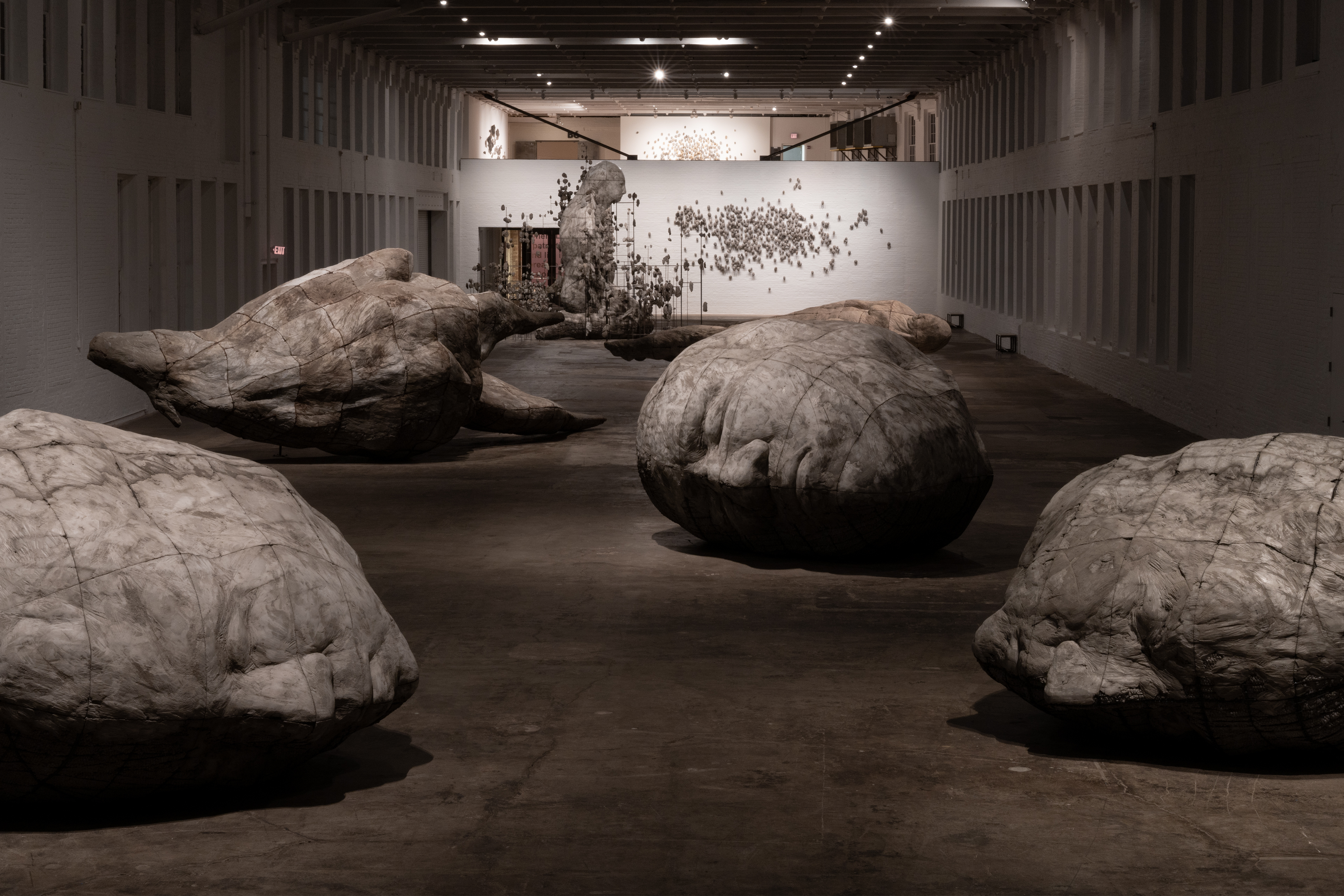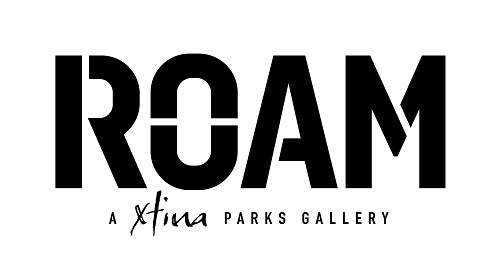Archive Exhibitions, Exhibition
- On view through January 24, 2021
- Building 5
Ledelle Moe’s weathered, monolithic heads and figures variously bring to mind the relics of an ancient civilization or statues toppled in the wake of political upheaval. On close examination, what appears to be timeworn stone reveals itself as concrete, and the massive forms show themselves to be constructed from many smaller sections. One might confuse the colossal objects — joined together with steel seams — with giant dolls shattered and carefully glued back together. Indeed, despite their immense size, they seem fragile. Hollow, with their interiors at times visible, these imperfect figures — fallen, recumbent, disembodied, marked and scarred with the traces of their making and aging — contradict the usual characteristics of traditional monuments and memorials. At the same time, they prompt questions about the individuals we choose to honor and remember.
Moe’s most ambitious new sculpture for MASS MoCA, an 18-foot-tall kneeling female figure is born from the artist’s interest in the persistence of monumental form throughout human history — the impulse to keep the past alive in the present. The specific posture of the towering sculpture — the centerpiece of the exhibition — is reminiscent of iconic images seen in cultures around the globe. Yet Moe’s figure has an unusual addition; the slightly androgynous statue is surrounded by a network of metal rods protruding from the body which support a constellation of ambiguous forms. The scaffold-like grid structure buttresses the individual subject within a collective organism. Hovering, swarming around her, the forms can be read as both emerging from and emanating outward — suggestions of strength and vulnerability, of acting and being acted upon. While her kneeling position conjures that of prayer or genuflection, Moe sees the pose as “an act of waiting… a moment before or after action.” With this ambiguous gesture, the monolithic sculpture looks both to the past and to the future. Such oppositions are at the heart of Moe’s works which grapple with the contradictions between our monuments and memorials and our lived realities — which encompass both the individual and the collective, a sense of place and displacement, permanence and impermanence.
Moe has spent nearly two decades thinking about monuments and the role they play, past and present, both on a personal level and in the public imagination. She began her ongoing series Memorial (Collapse) in 2005 as a tribute to anonymous victims of violent conflict around the world. She found stories in newspapers and on the internet and gave solid form to the fleeting lives as a way to process an enormous sense of grief. The giant heads — all male — laying on their sides, appear peaceful, as if asleep, like many of the subjects in Moe’s source images. The artist found their placid expressions a marked contrast to the brutality and trauma of their deaths. The artist gives these anonymous individuals literal and metaphoric weight, while referencing a long history of nameless victims of violence and war.
In other works, Moe references Classical funerary sculptures and Victorian-era cemetery monuments. The horizontal forms of Erosion (2009) — stiff, female figures clothed in flowing, pleated gowns — appear to have been knocked over from a once-upright position. They have the air of ruins, their title a reference to the decay of both built structures and memory over time.
In contrast to the violence suggested by these toppled figures, the massive, horizontal figures of Moe’s Relief series (2010) recline peacefully. Hovering several feet above the ground, they seem to levitate. Naked, with their arms at their sides, these sculptures bring to mind bodies carefully prepared for burial or giant effigies removed from their sarcophagi. The artist made these works after the deaths of her mother and grandmother. The horizontal thrust of the female forms diverges dramatically from the verticality and towering height of traditional monuments, such as the ubiquitous equestrian statues that populate nearly every town square. Moe symbolically upends this image of male power more directly with a large, horse-like figure from the same series. On its back, the awkward animal, straining with legs splayed, suggests a fallen mount, its rider missing. The vulnerable creatures reminds us of the uglier realities behind the heroism and victories usually immortalized in stone or bronze. The artist sees it as the metaphoric toppling of patriarchical power. The questions that have preoccupied Moe for nearly two decades are especially topical given global conversations about the monuments that populate our everyday landscapes and do not reflect — and even hinder — societal change. While protests in Moe’s hometown of Cape Town in 2015 provoked the removal of a monument to Cecil Rhodes and sparked an international movement, this year Confederate statues have been removed from public sites all over the U.S. While the elimination of these symbols of institutionalized racism are a welcome change, other more painful erasures, such as the destruction of the Buddhas of Bamiyan by the Taliban in 2001, are also suggested by Moe’s works.
Congregation (2006-2015) also plays with the tropes of historical precedents. The sprawling wall work is made up of hundreds of small heads, each the size of the artists’ fist. Rather than crafting a single monumental form, Moe implies size and scale through the accretion of multiple elements. The accumulation of faces — those of people she knows from around the world and those in her imagination — acts as an homage to the collective versus the individual. Reminiscent of flocks or swarms, the amorphous mass of heads also resembles a map without borders, bringing to mind the migration of both animals and people and the humanity which connects us all. Throughout her work, Moe blurs the line between human, animal, and landscape. Adding to the collection of heads over time, she mixes soil from the location where she is working into the concrete used for these — and other sculptures — making links between distant peoples and places, while acknowledging the significance of particular sites and their histories. Moe understands her use of soil from places both familiar and unfamiliar to her as “rooted in some longing to better understand how political and personal histories are inherent in the ever-present awareness of place. Or how ground, land, soil, and earth reference a sense of belonging.” Perhaps too, it is a reminder that we are all of — and will return — to the earth.
You can download a PDF of the exhibition guide here.
About the Artist
Ledelle Moe (b.1971, Durban, South Africa) graduated from Natal Technikon in 1993. She was one of the founding members of the FLAT Gallery, an alternative space in Durban. A travel grant in 1994 took her to the United States where she attended the Virginia Commonwealth University. She completed her Master’s Degree in 1996 before becoming an adjunct professor in the Sculpture Department at the Maryland Institute College of Art (MICA) in Baltimore. She has also taught at the Corcoran School of Art in Washington, DC, Virginia Commonwealth University, and St. Mary’s College of Maryland. Moe has exhibited in a number of international venues including the Pérez Art Museum Miami; Semaphore Gallery, Neuchâtel, Switzerland; Smithsonian Institution’s National Museum of African Art, Washington, D.C.; Smack Mellon, Brooklyn; the American Academy of Arts and Letters, New York; Socrates Sculpture Park, Queens, New York; and Kulturhuset, Stockholm, Sweden, among others. Moe’s work is permanently installed at the North Carolina Museum of Art’s Museum Park in Raleigh. In 2002 Moe was the recipient of a Joan Mitchell Award and in 2008 received the Kreeger Museum Artist Award. Moe is head of sculpture at the University of Stellenbosch in South Africa. She currently lives and works in Cape Town.
This exhibition is made possible through leadership support from Xtina and James R. Parks.
Additional support has been received from the Henry Moore Foundation. Programming at MASS MoCA is made possible in part by the Barr Foundation, Horace W. Goldsmith Foundation, and Mass Cultural Council.
Ledelle Moe
Memorial (Collapse), 2005-06
concrete and steel
8 x 12 x 9 feet each
Courtesy of the artist






